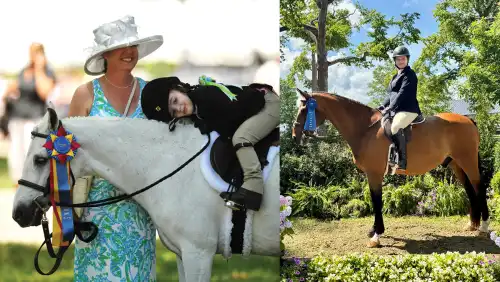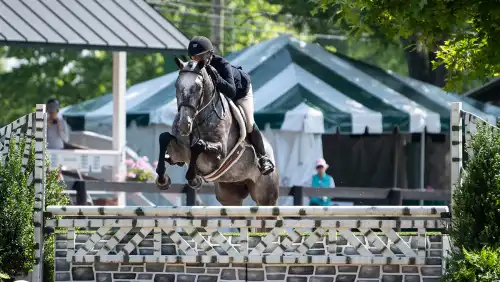After a sudden end to their bid last year, she and Shutterfly pull out a victory in Sweden.
The Rolex FEI World Cup Show Jumping Final is always a rollercoaster of emotions, and it was only a year ago that Meredith Michaels-Beerbaum found herself in one of the lowest lows in Las Vegas, Nev.
But this year’s competition, held in Gothenburg, Sweden, April 23-27, was her chance for reprisal, and it saw her back at the pinnacle of the sport with her longtime partner, Shutterfly.
A U.S. rider broke into the top three for the first time since 1989—Rich Fellers rode Flexible into second place. “I felt a bit surprised that my horse performed as well as he did,” Fellers admitted. “He doesn’t have the experience that Shutterfly has. But I’m quite confident. He improved through the week, and by the end he was at his best. I was thrilled to death when he jumped a clear round in the [final] round.”
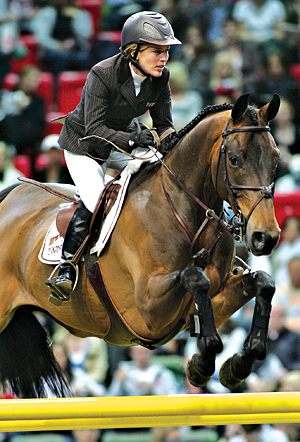 This is the second World Cup victory for the Hanoverian gelding Shutterfly (Silvio I–Famm) and Michaels-Beerbaum, the team and individual bronze medalists at the 2006 World Equestrian Games (Germany).
This is the second World Cup victory for the Hanoverian gelding Shutterfly (Silvio I–Famm) and Michaels-Beerbaum, the team and individual bronze medalists at the 2006 World Equestrian Games (Germany).
They won the 2005 Budweiser FEI World Cup Final in Las Vegas, but their performance there last year didn’t go as smoothly. The pair was in first place going into the final day, but was eliminated after Michaels-Beerbaum was jumped loose over an oxer and fell off around the next turn in the penultimate round.
“To be quite honest I thought about last year’s Final on Friday night when there was a tough distance with a short oxer going up to the end of the ring,” she said. “I thought, ‘You’d better not fall off.’
“Today when I was walking the second course I thought, ‘Well you made it farther than you did last year’,” she added with a laugh.
Sitting in a comfortable fifth place after Thursday’s speed round, the pair’s only mistake came during Friday’s Round 2 grand prix, where they incurred 1 time fault. That kept them out of the jump-off that night, but served to move the 15-year-old Shutterfly into a three-way tie for fourth.
“He jumped beautifully on Friday night, and I was a little disappointed with the time fault,” she said. “Technically I was leaving the door open for the others. But I needed to add the strides in the lines, and that takes time, so there really wasn’t much that I could have done.”
Shutterfly moved into the lead on Sunday morning with a clear round and then followed that up with a
second clear.
With clear rounds scarce and not even a rail in hand, Michaels-Beerbaum had no room for error, but Shutterfly cleared almost every fence with room to spare. The gelding rubbed the top rail on the final jump, a narrow vertical off a difficult distance that served as the bogey fence on the last course, and Michaels-Beerbaum whipped her head around in suspense as they galloped across the finish line. But the rail stayed in the cups, and a crowd of 12,000 spectators roared their approval, as the pair finished the week’s four demanding courses without a single jumping fault.
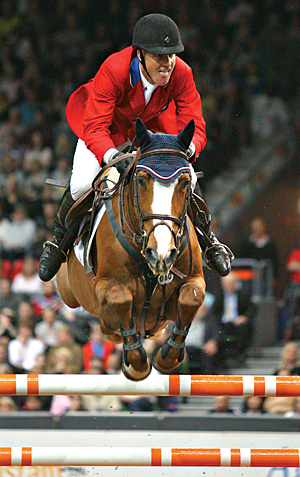
“Shutterfly showed that he was in wonderful form,” Michaels-Beerbaum said. “I have to say that I’m proud of myself too, if I’m allowed to say that. It’s a lot of pressure to ride the greatest horse in the world. If you mess up, everyone says it was your fault!”
Second Final; Second Place
U.S. rider Rich Fellers may not have expected to win this year’s Final, but he was more than happy to find himself in a position to apply pressure to his expatriate friend in Sunday’s last round.
“I’ve seen Meredith ride since she was a young girl in California,” Fellers said afterward. “She’s a pressure rider. I have to say, I had a lot of confidence that she was going to jump clean and win.”
In comparison with the massive European fame of Michaels-Beerbaum, a low-profile rider from Oregon was barely a blip on the radar screen when he arrived on his first trip to Sweden and only his second World Cup Final performance. But Fellers out-performed even his own expectations with Flexible.
“I was very hopeful that I could be competitive, but I had a big question mark whether this little horse would have the ability to stretch like he did,” Fellers admitted. “He’s an inexperienced horse at this level. Since he’s quite a small horse [at 16.0 hands], I felt he might be stretching his limits. I think the biggest question for that horse and for myself would be if he has the range and scope for big wide fences in a small ring, and he seems to be finding it.”
Because he counts family time with his wife and two children, ages 14 and 16, as a high priority, Fellers travels and competes less than most top show jumpers. Although he’s ridden on a few European tours in the past, he prefers to stay on the West Coast and compete at the HITS Thermal (Calif.) and Spruce Meadows (Alta.) venues.
“In our country we tend to compete maybe too much,” Fellers said. “I just don’t compete as much as the other riders. It suits my customers, and it very much suits my family life. I have two wonderful children, and I want to be a big part of their life as they grow up.”
ADVERTISEMENT
While their chosen outings may have been fewer and farther between than many others in Gothenburg, Fellers and Flexible had been on a winning streak before coming to Sweden. They topped three of the four World Cup-qualifiers at HITS Thermal, and Fellers credited that facility’s new temporary indoor arena, which was erected especially for the West Coast qualifiers, as key in his preparation for the Final.
A Last-Minute Wylde Ride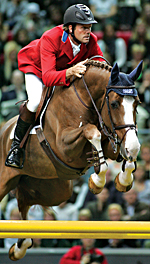 While Fellers emerged as the top U.S. rider at the end of the FEI Rolex World Cup Final, Peter Wylde put in a noteworthy performance of his own, finishing in a tie for seventh with Esplanade 7. Wylde, who trains in Maastricht, the Netherlands, came as a last-minute substitution for McLain Ward and drew plenty of applause over the course of the week with Louisburg Farm’s and Elizabeth Johnson’s 10-year-old Dutch Warmblood mare (Hamilcar–Ziriegonda). “All fall I was in America and got all my points in the East Coast League,” he said. “I was the 12th American to qualify, and they only take seven from the East Coast. But I had a hint that this might happen. I started calling up the USEF, and they said it probably wasn’t going to, but I had a feeling that it might. “We flew all 12 of our horses back over [to Europe] in March,” he continued. “They were super fit, so they got two weeks of going out in the woods and having a good time, then two more weeks to get them tuned up again. I got the phone call the Tuesday before the show. I was actually entered at a show in Hagen, Germany, and I had to call them and tell them I was very sorry, but I was going to have to pull out and go to the World Cup.” Wylde competed in the U.S. Olympic selection trials in Wellington, Fla., this spring with two horses, Campino 103 and Irco Sun, but both were eliminated in the same combination in Round 2. But it was Esplanade, who Wylde said he felt wasn’t ready for the Olympic Trials at the time, who emerged as the star in Gothenburg. “I’m thrilled about my horse,” he said. “She’s brilliant, but she’s green. She’s extremely careful. She still goes too high in the air though, which is nice, except when you have really wide oxers. “She did her first grand prix only a year ago,” he continued. “My first show was here in Gothenburg with her last year. It’s amazing that she’s here at all, so I felt like I should really take each leg as a class of its own.” That step-by-step strategy paid off, as Esplanade logged clear rounds in Thursday’s speed round, Friday night’s round and jump-off, and Sunday’s final round. Wylde got the ride on the mare last spring and said he was just looking for her to gain some good experience in the Final. “I felt like she was about to turn a corner,” Wylde said. “You don’t get a horse like this that often. I’m not in this to become a millionaire. I’m in this because I love being able to compete in a championship with a horse like this. To get to do these kind of shows with a horse that can perform like that—that’s why we do it. |
“It was so different coming here with a horse that had jumped indoors,” he said. “You can’t really expect to qualify on big outdoor courses and then do well indoors at the Final. [HITS CEO] Tom Struzzieri really deserves credit for making that a priority.”
Preparation was the name of the game for Fellers, who has had the ride on Flexible for the past 5 1⁄2 years, waiting patiently for the right chance to step him up. The chestnut stallion has bounced back from his fair share of injuries. Several years ago veterinarians performed a surgery similar to human angioplasty on him after they discovered a blockage in a major vein in his right front leg, which wasn’t allowing blood to drain from the appendage properly.
“As soon as he would go into work and get his blood pumping, he would go lame,” Fellers said. “They didn’t think it would fix him, but he was out for more than a year and then came back.”
Then in 2005 he fractured his shoulder in a freak pasture accident. Again, the outlook looked grim, but the game little chestnut eventually made it back into work and back into the spotlight.
In Gothenburg, the pair put in a truly textbook performance to take fourth place in the speed leg. After a double-clear round in Friday’s Table A class, Flexible got a chance to prove his prowess for turns in the jump-off. The Scandinavium crowd gasped and cheered progressively louder as the pair cleared each fence,
eventually reaching a roar as they galloped to the final jump, only to drop the back rail. They finished fourth, but moved into second place overall. And with one rail down in Sunday’s Round A, they dropped to third, but battled back again in Round B with another clear round.
“It was the hardest World Cup Final I’ve ever jumped, and it was only my second one,” Fellers joked. “I didn’t make it to the last two rounds in the last Final. I thought the course was massive. You just kind of had to not think about that.”
Downright Difficult
If the riders had to agree on one adjective to describe this year’s World Cup courses, built by Rolf Lüdi, it likely would have been just plain “hard.”
“I think the courses were brilliant,” Michaels-Beerbaum assessed. “But I also did think that this was one of the hardest World Cup Finals I’ve ridden in, and I think I’ve ridden in maybe seven now. This was for sure one of the biggest ones.”
U.S. rider Peter Wylde, who tied for seventh overall (see sidebar), and who competes regularly on the indoor European circuit and tallied this as his sixth World Cup Final, was in whole-hearted agreement about Lüdi’s track.
ADVERTISEMENT
“[Friday’s] was an extremely difficult course—one of the hardest indoor courses I’ve ever ridden,” Wylde said “The oxers were extremely wide, and you had to be very precise on those jumps. But the World Cup Final is supposed to make the best in the world grunt.”
Sunday’s second course caused plenty of heartbreaking rails as well, particularly at the last fence.
“It wasn’t the fence so much as the distance,” Fellers said. “It was very cleverly set by our course designer and left us all a bit confused if we wanted to make four strides or go forward and make three. It just came down to precision.”
The sheer difficulty of the courses made the performances of several U.S. riders all the more impressive, however. Two of the five riders in the Friday jump-off were sporting American flags on their jackets, and all but one rider, Margie Engle, made the cut to continue on to Sunday’s final rounds.
Like Fellers, Wylde and Esplanade 7 also logged a clear round Sunday afternoon to bounce back from their previous three-rail round. Kent Farrington landed in 13th place with Up Chiqui after pulling just one rail in each of Sunday’s rounds. Close on his heels were Lauren Hough and Quick Study, who had two rails in Round A and one rail with 1 time fault in Round B, placing 14th.
Richard Spooner took 18th place with Cristallo, followed by Mandy Porter in 19th with Summer. Brianne Goutal did not jump in Sunday’s Round B, while Todd Minikus retired during Round A.
On the whole, U.S. Team Chef d’Equipe George Morris was “very happy” with his riders’ performances.
“There were 10 horses here, and in the Super League we have another nine,” he said. “So we have almost 20 [combinations] who are at least decent at this level. That’s depth. We work to encourage and nurture depth, so I’m very encouraged.”
Torano Turns Some Heads After putting in a slow round with two rails in the speed leg, World Cup Final rookies Danielle Torano and Vancouver D’Auvray were the lowest-placed U.S. pair. But by the end of the final round on Sunday, their collective performances had caught the attention of the European contingent and could easily have earned a “most improved” award at the competition.
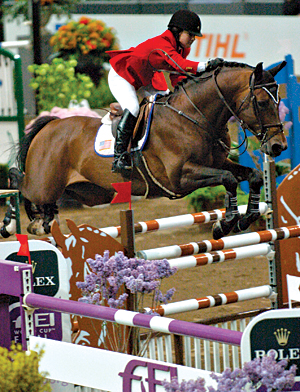 “I had been to the World Cup in Gothenburg before, but as a spectator and not a rider,” Torano said. “So you think you know what it’s going to be like, but then you get there and realize you have no idea. I’d seen some of these riders, but I don’t know them. I thought, basically, ‘Just don’t go and make a disaster.’ ”
“I had been to the World Cup in Gothenburg before, but as a spectator and not a rider,” Torano said. “So you think you know what it’s going to be like, but then you get there and realize you have no idea. I’d seen some of these riders, but I don’t know them. I thought, basically, ‘Just don’t go and make a disaster.’ ”
Torano, 34, of Ft. Lauderdale, Fla., is married to fellow international show jumper Jimmy Torano, so she knows the ins and outs of competitions. She and Vancouver D’Auvray, a 10-year-old Belgian Warmblood stallion owned by Sir Ruly Inc., have been competing together for two years. But riding in her first European show was a huge step up in her own riding career.
“I took another horse along—Marlo—to do in some other classes,” she explained. “And once I got here I kind of wondered whether it was worth it, because it was so expensive, but I ended up being so glad I did. It was pretty nerve-wracking walking in [to the Scandinavium Arena] the first time. I’ve never been to a show that has that kind of atmosphere and feeling to it.”
Torano’s breakthrough performance came in Friday’s grand prix leg, where her scopey, forward round earned her 10th place. Vancouver had a few hard rubs, but only one rail fell. They added 1 time penalty. Their score stood as the best for 10 more rounds, until Torano’s fellow American Lauren Hough took over the lead.
“I walked that course and thought, ‘Oh my gosh, these are huge,’ ” Torano said. “I had one rail down, but my horse just jumped as well as he could have jumped. That was pretty exciting to be sitting there halfway through the class and see my name and my horse’s name still leading.”
With two 8-fault rounds on Sunday, Torano finished in 17th place overall.
“Danielle has a great talent and a great touch,” U.S. Chef d’Equipe George Morris said. “She showed at this competition that she can be right there. She’s very tactful in her riding.”
“For my first time I was really happy with my results with both my horses,” Torano said. “I rode the best I could. But I wish I could go back now and do one more round and figure it out a little bit. If I could do it again, I think I could make it a little bit better. Hopefully we’ll be back again.”
Kat Netzler









